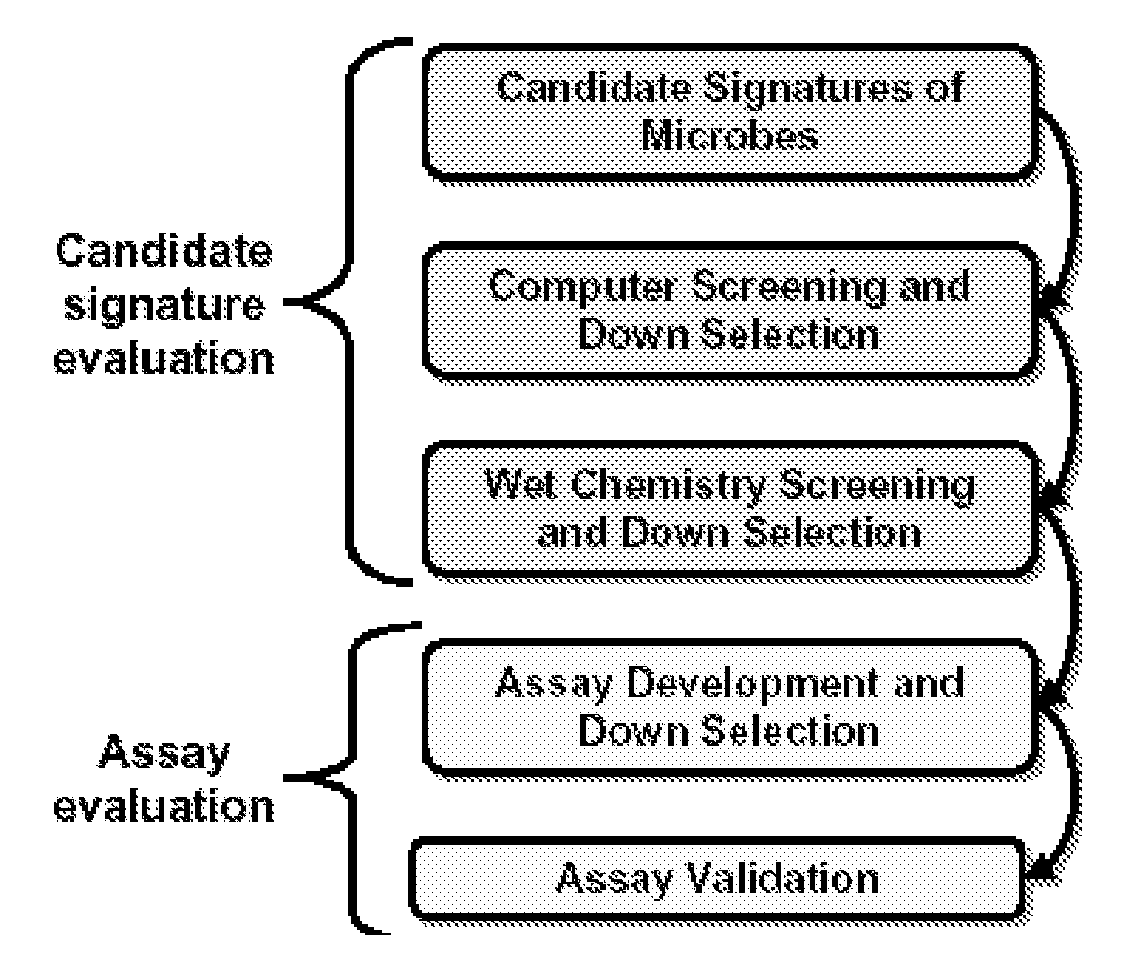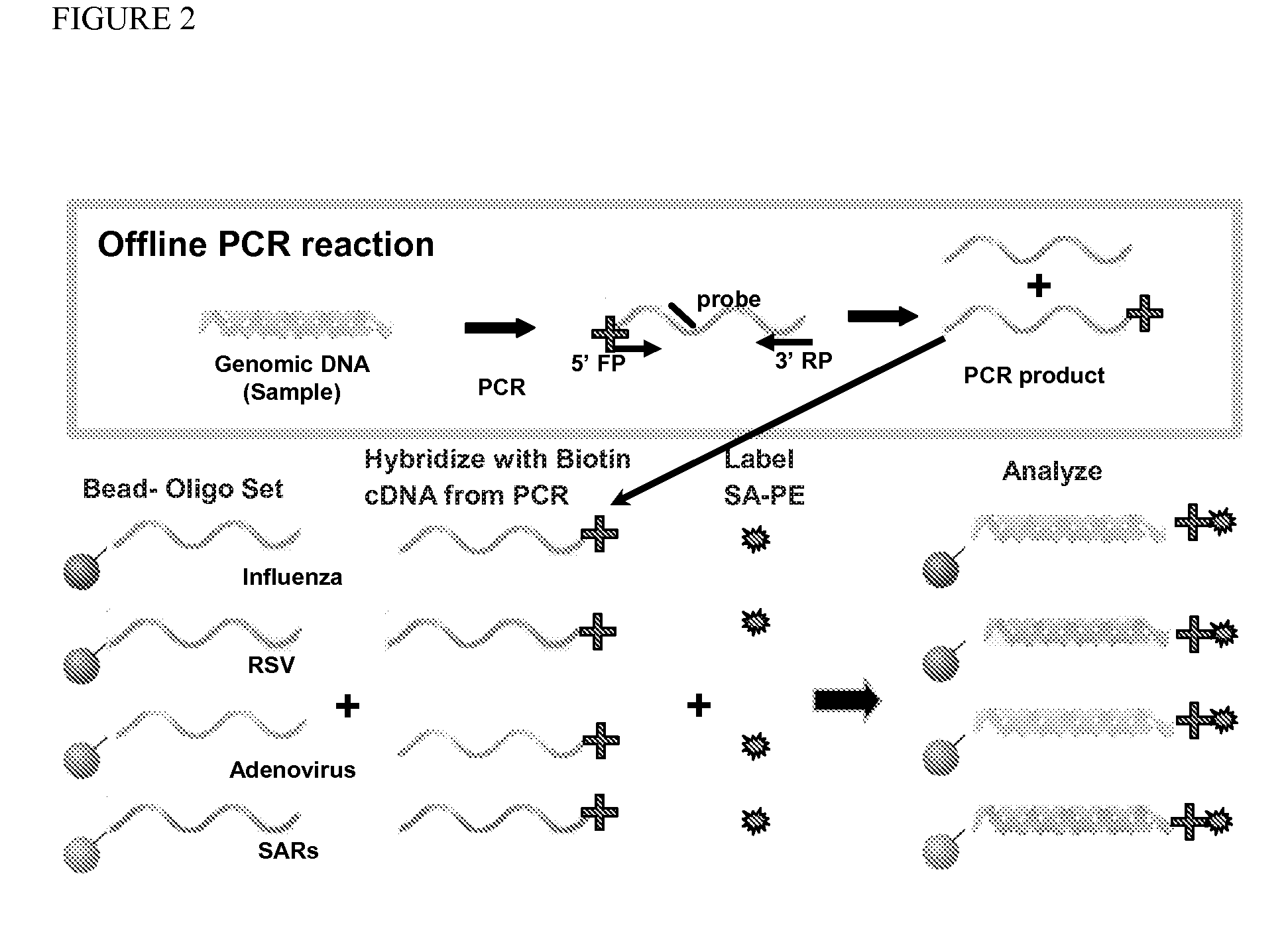Multiplex detection of respiratory pathogens
a multi-agent, respiratory pathogen technology, applied in biochemistry apparatus and processes, fermentation, organic chemistry, etc., can solve the problems of insufficient sensitivity and specificity of assays, low detection efficiency, and labor-intensive methods
- Summary
- Abstract
- Description
- Claims
- Application Information
AI Technical Summary
Benefits of technology
Problems solved by technology
Method used
Image
Examples
example 1
In-Silico Identification of Candidate Signature Sequences
[0120]The LLNL Bioinformatics team developed “KPATH”, a whole-genome comparative analysis software system. The general approach is the following: All available complete genomes of different strains of the target species are compared using multiple genome alignment programs. A consensus gestalt is formed from the alignments that contain the sequence conserved among all target inputs. This step is bypassed if only one target sequence is available. To establish that the organism-conserved sequence does not occur in any other sequenced microbial organism, the consensus gestalt is compared against the LLNL updated database of microbial organisms. A customized algorithm accomplishes this electronic subtraction, and the result is a uniqueness gestalt that is mined for potential signature candidates. A final computational screening is done to verify that cross-reactions are not detected.
[0121]KPATH allows the genome to define potentia...
example 2
Use of Taqsim to Further Screen Candidate Signature Sequences
[0128]A computational TaqMan simulator program, “Taqsim”, was used to identify all potential targets for each candidate signature from all sequences available in Genbank. Taqsim is a BLAST-based comparison of each signature as a triplet against all sequences in Genbank to identify the targets that are predicted to produce a TaqMan reaction at 57 degrees primer annealing and 67 degrees for probe annealing (these temperatures are according to Primer 3 oligo Tm calculations). Input parameters allow for standardized signature informatics that allows for universal protocol development and assay compatibility.
TABLE 3Taqsim settings used for generation of candidate signaturesPrimer3 ParametersStandardParametersSettingsPRIMER_OPT_SIZE20PRIMER_MIN_SIZE18PRIMER_MAX_SIZE27PRIMER_PRODUCT_OPT_SIZE100PRIMER_PRODUCT_SIZE_RANGE71-600PRIMER_OPT_TM62PRIMER_MIN_TM61PRIMER_MAX_TM63PRIMER_MIN_GC20PRIMER_MAX_GC80PRIMER_PICK_INTERNAL_OLIGO1PRIME...
example 3
Wet Chemistry Screening Process
[0129]To ensure extremely high selectivity and sensitivity, a rigorous wet-chemistry screening was performed to further down-select candidate nucleic acid signatures before taking those signatures that pass this screening on to assay development. This step ensures that the primers will detect the strain diversity of the pathogen, but will not react with the nucleic acids of other organisms that could be present in a sample. At this stage, only the primers are tested and many unsuitable primers (e.g., those that form primer-dimers, those that do not produce amplicons of the correct size, etc.) can be eliminated in this first step.
[0130]An initial screening of the PCR signatures was performed in duplicate using end-point PCR and gel electrophoresis as described herein. The signatures are initially screened against nucleic acid extractions from 5 soils, 5 eukaryotic nucleic acids, and 5 microbes, each picked at random, and selected near neighbors. The soi...
PUM
| Property | Measurement | Unit |
|---|---|---|
| wavelengths | aaaaa | aaaaa |
| wavelengths | aaaaa | aaaaa |
| pH | aaaaa | aaaaa |
Abstract
Description
Claims
Application Information
 Login to View More
Login to View More - R&D
- Intellectual Property
- Life Sciences
- Materials
- Tech Scout
- Unparalleled Data Quality
- Higher Quality Content
- 60% Fewer Hallucinations
Browse by: Latest US Patents, China's latest patents, Technical Efficacy Thesaurus, Application Domain, Technology Topic, Popular Technical Reports.
© 2025 PatSnap. All rights reserved.Legal|Privacy policy|Modern Slavery Act Transparency Statement|Sitemap|About US| Contact US: help@patsnap.com



